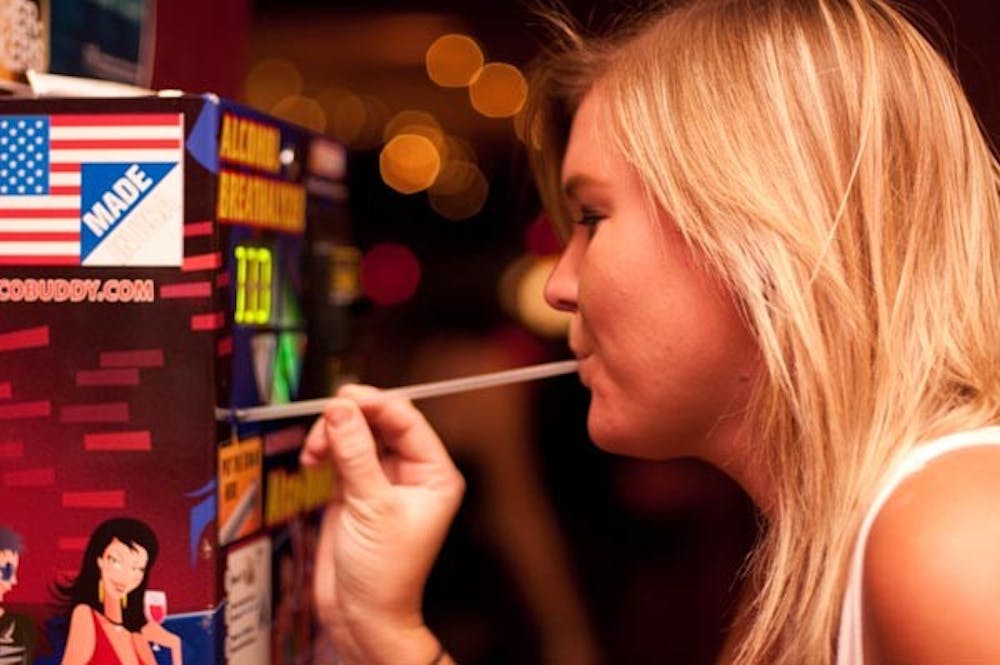The way Mark Krems sees it, there are two types of breathalyzers — one costs $1, the other costs $10,000.
Krems and his son, Freddy Krems, the owners of a Scottsdale-based company called Blo-Safe, install wall-mounted breathalyzer machines in local bars, clubs and restaurants for patrons to monitor their blood-alcohol content before driving, or as Mark says, “Blow before you go.”
Freddy Krems, better known locally as DJ Circle, is a 2006 ASU graduate and the impetus for Blo-Safe, and said he hopes to curtail people from driving under the influence.
“People need to know where they’re at,” Krems said. “Even if they don’t feel intoxicated, the machine will tell them different.”
Mark Krems said he’s not only interested in preventing DUIs, but also preventing deaths and injuries related to people driving under the influence.
“I know we’re saving people’s lives, and we’re saving people from DUIs,” Krems said. “I know it in my heart.”
Several breathalyzer machines are already installed in Tempe- and Scottsdale-area bars, Krems said, including Philly’s Sports Bar and Grill and Zuma Grill in Tempe, as well as Martini Ranch and Mulligan’s Brick Bar in Scottsdale.
The machines, which the father-son combo installs for free in any willing restaurant across Arizona, measure the user’s blood-alcohol content within .01, Mark Krems said.
The machines, manufactured by New York-based Alco-Buddy, cost nearly $2,000 each, according to the company’s website.
After inserting a dollar into the machine, a nine-second countdown lights up, and the user inserts a regular drinking straw into a hole in the machine, and blows into the straw until the blood-alcohol content displays on a digital readout.
Judy Garrick, the general manager of The Titled Kilt in Peoria, said the breathalyzer installed by Blo-Safe gets used on a regular basis.
“They’re fascinated,” she said. “Do I see people taking a shot and seeing how high they can blow? Yes, but I do see plenty of people using it for the right purpose.”
There is no permanent record of the readout, Mark Krems said, and the machine relieves Blo-Safe and bars from liability with a label proclaiming it is “for entertainment purposes.”
While the machines are labeled “for entertainment purposes,” he said they do serve a very real purpose.
“The machines can raise attention to people,” Krems said. “And that’s all they’re supposed to do, that they’ve been drinking, and maybe shouldn’t drive.”
It’s also possible that insurance companies will lower the bar insurance cost to places that utilize the machines, Krems said.
Although it hasn’t happened yet, Krems said insurance companies “love” the machines, and the decrease in liability resulting from the breathalyzers could qualify bars for reductions in insurance prices.
Freddy Krems said he wanted people to use the machines to avoid drunk driving because he’s seen it happen too many times before.
“I saw people leaving the club just hammered,” he said. “Pretty much all my friends have gotten DUIs.”
Mark Krems has even more rhymes and reasons for people to use his machines and avoid driving under the influence.
“Blow in the bar, blow in the car, it’s your choice,” he said. “I’m sure we’re saving a few lives, and we’re keeping people away from Sheriff Joe’s tent farm.”
He said he believes he can get local law enforcement agencies to endorse the breathalyzers, with the hope of getting the endorsement of Maricopa County Sheriff Joe Arpaio in the immediate future.
“The bars will really open up [to the idea] once the police endorse it,” Krems said.
During the company’s “coming out party” at the 42,000-attendee Scottsdale Culinary Festival in April, Krems said he not only introduced the devices, but also the Blo-Safe girls.
“Hooters has their girls; we have our girls,” Krems said.
He also hopes to work out deals to install the machines in local stadiums and advertising arrangements with local cab companies to be placed on the machines.
Krems said installing the machines in bars could work in the bar’s advantage because not only would the business receive some of the vending profit, they are installed for free, and can even help bartenders deal with customers who may have had one too many.
“Rather than argue with people, tell them to go over to the machine,” Krems said. “And let them have at it with the machine.”
Every month, Mark and Freddy Krems perform maintenance on all the machines, including calibration, replacing the straws, and if needed, replacing the actual breathalyzer unit — for free.
“We don’t charge for the machines,” Mark Krems said. “We split the proceeds with them, and if they want us to remove them, we’ll remove them.”
As a warning, he said there are a few factors that can influence the machines’ readings.
Krems recommends waiting at least 45 minutes after a person’s first drink, and 10 minutes after the last sip from any following drink to ensure an accurate reading.
“If they take a shot and use the machine, they might blow a 0.9 … off the Richter scale,” he said.
For good measure, Krems made sure to get all of the Blo-Safe rhymes out of his system.
“Check yourself before you wreck yourself,” he said.
Reach the reporter at mhendley@asu.edu





